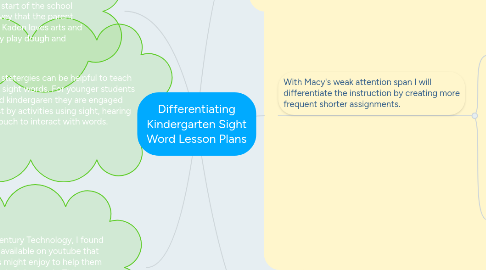Differentiating Kindergarten Sight Word Lesson Plans
por London McKinnon


1. Multisensory statergies can be helpful to teach these instant sight words. For younger students preschool and kindergaren they are engaged and learn best by activities using sight, hearing tasting and touch to interact with words.
1.1. Palm writing involves writing words in the palm of your hand
1.2. Rainbow writing involves writing words over and over in different colored markers
1.3. Making sight words out of Arts and Crafts products such as play dough since it is Kaden's favorite. Most of the other students will also enjoy this activity.
2. Learning Profile # 2 Kaden is a 5 year old with A reading delay, not able to quickly recognize more than 10 sight words. From the start of the school year interest survey that the parent filled out, I know Kaden loves arts and crafts particularly play dough and music.
3. Using 21st century Technology, I found some songs available on youtube that the students might enjoy to help them memorize their sight words. This particularly will be good for Kaden since he loves music and relates to it.
3.1. Music:
4. With Macy's weak attention span I will differentiate the instruction by creating more frequent shorter assignments.
4.1. One fun game that can act as a short lesson and a transition is Bingo. This can be done on a Smart board or projector while all of the students have their own place boards. Bingo is a great game to play to help memorize common sight words. For children struggling to learn words, starting with only nine words on the board, working up to 25 words eventually. If all students have iPads in the classroom this can also be completed on the iPad..
4.1.1. BINGO!
4.2. Racetracks can be made out of cardboard or game boards. Students choose a matchbox car to drive along the racetrack while reading the words aloud. The children race from start to finish by saying the words quickly. This encourages children to engage in learning words with a focus on saying the words quickly, within one to three seconds. Words can be slowly replaced with new words as memorization improves.
5. Learning Profile # 1- Macy, a 6 year old diagnosed with ADHD. She has a very weak attention span and a low working memory along with expressive language.
5.1. Teacher Stratergy: Working with students in a less distracting environment on a modified curriculum using sight words.
5.1.1. This strategy begins with a teacher or trained tutor reading the text to the student with expression and proper pacing, then the child reads it out loud with support. The teacher asks several questions about the text to gauge understanding. Finally, the child reads it again independently. I do it, we do it you do it
